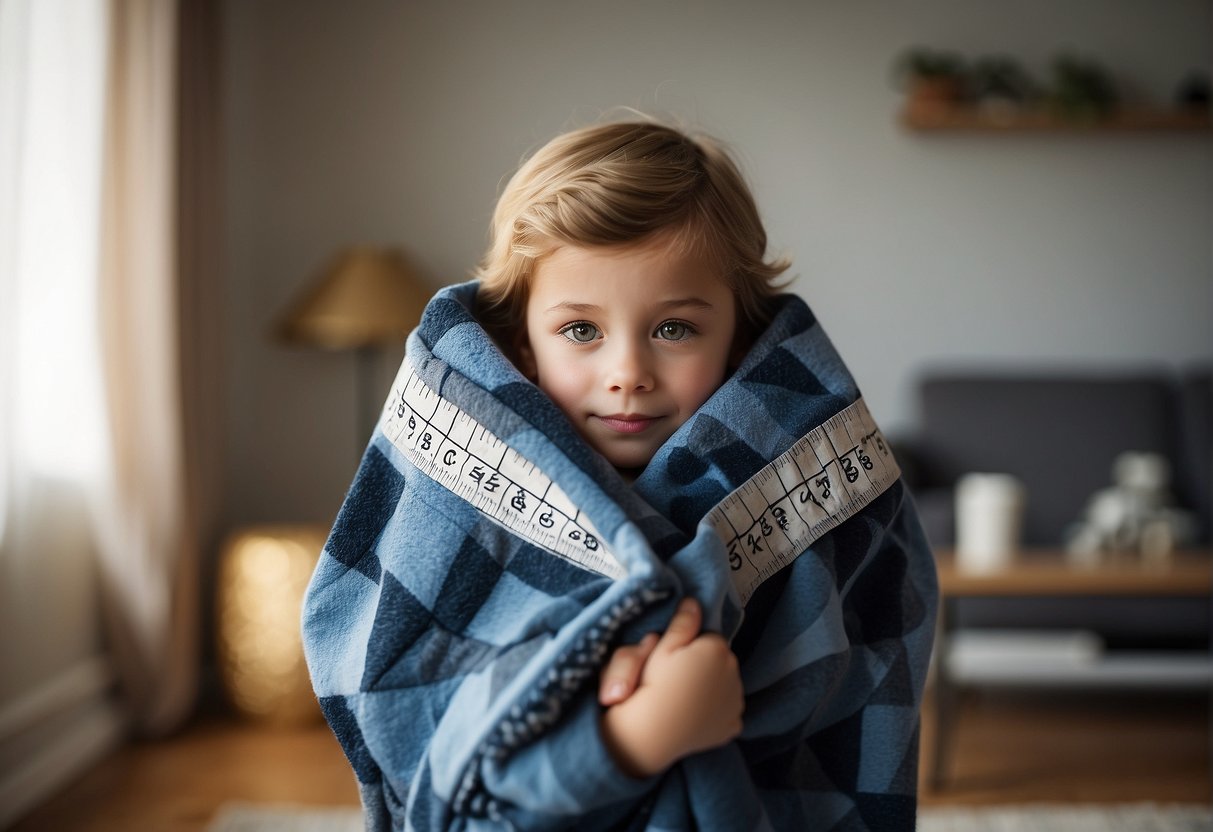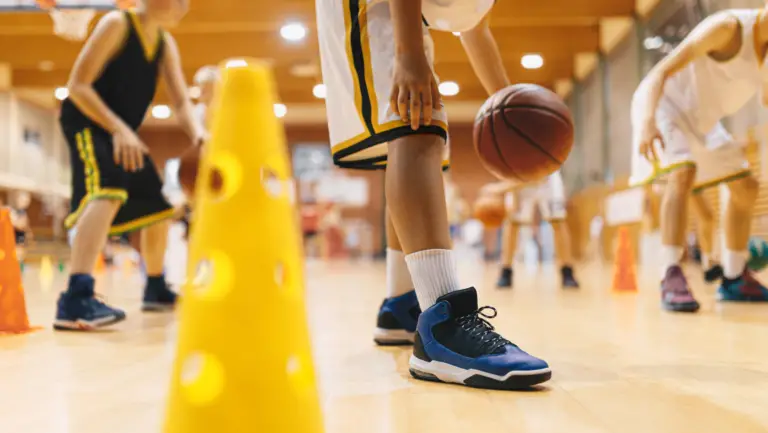Discover the perfect cozy companion for your little one’s sleep routine with our guide on ‘What Size Weighted Blanket for Kids’. Unravel the mystery of sizes and weights to ensure your child’s comfort and security all night long.
Understanding Weighted Blankets for Kids

When considering a weighted blanket for your child, it’s essential to understand the benefits, necessary safety precautions, and how to select the appropriate weight and size to ensure comfort and effectiveness.
Benefits of Weighted Blankets for Children
Weighted blankets offer deep pressure stimulation, which can resemble the feeling of being hugged. This sensation may help improve sleep quality and reduce anxiety in kids, including those with ADHD or autism. An occupational therapist can help determine if a weighted blanket could benefit your child.
Safety Considerations and Precautions
Safety is paramount when it comes to weighted blankets for kids. The blanket should be the right size to prevent suffocation and should not exceed 10% of the child’s body weight. It is recommended to consult with a pediatrician before use, especially for toddlers, babies, and infants due to risks such as SIDS, sleep apnea, or asthma.
Choosing the Right Weight and Size
To ensure safety and effectiveness, the appropriate weight of a weighted blanket for a child should be around 10% of their body weight, plus one to two pounds. The size should be such that your child can’t get tangled in it, ensuring both comfort and safety. Always opt for a size that’s manageable for your child to move under to minimize any risk. For specific dimensions, weighted blanket guidelines suggest varying sizes and weights based on age and body weight.
Weighted Blanket Materials and Maintenance

When selecting a weighted blanket for your kids, the materials used are crucial for ensuring comfort and ease of maintenance. Blankets are commonly filled with materials like glass beads or plastic poly pellets, which add weight. Some may even use ball bearings or natural fillers for heft.
Cotton is a popular choice for weighted blankets due to its soft, breathable nature, making it suitable for children who sleep hot. Variants such as organic cotton offer a hypoallergenic option, often in a variety of colors.
For a cozier feel, minky fabric is another favorite. It’s soft to the touch and commonly found in kids’ blankets. Meanwhile, knit weighted blankets present a less bulky alternative, with an open weave allowing for ample airflow.
In terms of maintenance, here’s a quick guide:
- Machine Washable: Many blankets can be machine washed for easy cleaning. Always follow the care label instructions.
- Drying: Some can be tumble-dried on low, while others may recommend air drying.
- Removable Covers: Opt for blankets with covers for simple laundering.
| Material | Maintenance | Features |
|---|---|---|
| Cotton | Machine washable | Breathable, Soft |
| Minky | Machine washable (cover) | Cozy, Soft |
| Knit | Spot clean | Breathable, Less bulky |
| Organic Cotton | Machine washable | Hypoallergenic, Eco-friendly |
Look for moisture-wicking materials if your child tends to sweat at night. Lastly, keep in mind that the weight and size of the blanket should be appropriate for your child, typically around 10% of their body weight plus a pound or two as suggested by Sleep Foundation.
Shopping Tips for Weighted Blankets

When you’re exploring the market for a weighted blanket for your child, there are a few key points to consider to ensure their comfort and safety:
- Size and Weight: The ideal weighted blanket for kids should be about 10% of their body weight plus one to two pounds. For example, a child who weighs 50 pounds might do well with a 5 to 7 pound blanket. Check out Best Weighted Blankets for Kids of 2024 for size options.
- Materials: Look for blankets filled with plastic pellets or glass beads that are hypoallergenic and non-toxic. The outer material should be soft—options like minky, organic cotton, or polyester can provide different touches of comfort.
- Design: Kids love colors and patterns, so select a blanket with color options that align with their preferences. A fun design can make bedtime something they look forward to.
- Care: Consider how easy it is to clean. A machine-washable blanket like Best Washable Weighted Blanket For Kids: Luna Kids Weighted Blanket can be a lifesaver.
- Budget: The pricing of weighted blankets can vary widely. It’s important to find a budget-friendly option without compromising on quality. The YnM Kids Weighted Blanket offers a good balance of quality and value.
- Safety: Ensure that the blanket is secure and with evenly distributed weight, so it doesn’t shift during the night. If your child has any health conditions, it’s a good idea to consult with a doctor or therapist before use.
- Extras: Some blankets offer unique features, such as cooling fabrics for children who sleep hot. The Bearaby Nappling is known for its cooling properties.
Remember, finding the right weighted blanket is about combining elements that match your child’s needs for a restful sleep. Happy shopping!
Frequently Asked Questions
Choosing the right weighted blanket for your child involves understanding the specific weight and size that will provide comfort without overwhelming them. Here we’ll cover some common questions to ensure you can select the best option for your little one’s needs.
How heavy should a weighted blanket be for a child?
The guideline for the weight of a child’s weighted blanket is typically 10% of their body weight plus one or two pounds. This ensures the blanket is heavy enough to provide comfort without being too heavy for safety.
Can a 3 year old use a 5 lb weighted blanket?
Yes, a 3 year old can use a 5 lb weighted blanket if it corresponds to the recommended guideline of 10% of their body weight plus one or two pounds. Always supervise young children when they use a weighted blanket to ensure they can move freely.
What size weighted blanket does my child need?
The size of a weighted blanket for your child depends on their size and preferences. Usually, it should be large enough to cover them comfortably without hanging over the sides of the bed, preventing them from kicking it off while sleeping.
Is a 10 lb weighted blanket too heavy for a child?
A 10 lb weighted blanket could be too heavy for a child who weighs less than 80-100 pounds. It’s important to adhere to the 10% body weight guideline, adjusting for the unique needs and comfort of your child.
What are the guidelines for choosing a weighted blanket for toddlers?
Weighted blankets for toddlers must be light enough for them to move easily. Stick to the 10% body weight guideline, and consider a lighter option if necessary. Ensure the blanket isn’t too large, as it could pose a potential risk if a toddler gets tangled in it.
What’s the recommended weighted blanket size for a teenager, such as a 14 year old?
Teenagers can usually handle a heavier weighted blanket. The best size is one that matches their weight according to the 10% rule, so a weight appropriate to a teenager’s body can range from 10 to even 25 pounds for larger teens.






